Hello All,
I originally struggled to get Web of Science to give me articles related to my interests. Entering terms like “Brazilian history” produced over 5,500 hits with articles concerning topics like the prevalence of the syphilis virus in female prisons, or the spatial niche modelling of five endemic cacti from the Brazilian Caatinga. Instead of “topic” searches, then, I chose “publication name” and limited my results to those of the top academic journals in my field. I was interested in seeing if there were notable differences between the journals’ word networks. For this post, I will present five related journals: Hispanic American Historical Review (HAHR), Journal of Latin American Studies (JLAS), Latin American Research Review (LARR), Revista de Indias, and Luso-Brazilian Review (LBR).
First is the Latin American Research Review (3,037 search results; 16,414 terms with 318 meeting the threshold = 1.94%):
“The Latin American Research Review (LARR) publishes original research and review essays on Latin America, the Caribbean, and Latina/Latino studies. LARR covers the social sciences and the humanities, including the fields of anthropology, economics, history, literature and cultural studies, political science, and sociology. The journal reviews and publishes papers in English, Spanish, and Portuguese. All papers, except for book and documentary film review essays, are subject to double-blind peer review. LARR, the academic journal of the Latin American Studies Association, has been in continuous publication since 1965.”
The first time I ran the program with LARR’s articles, the network was dominated by the word “America.”
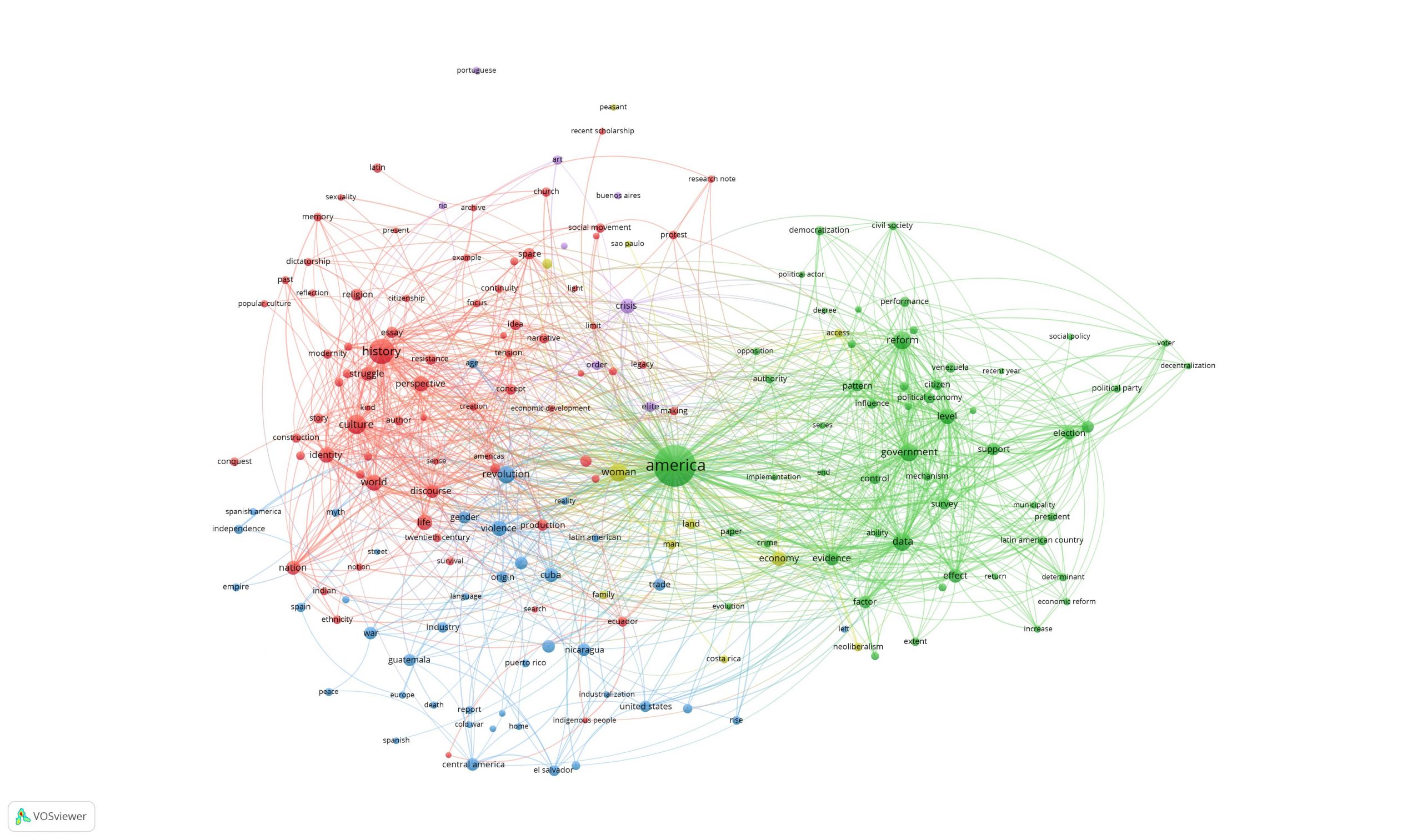
I found this to be unhelpful because the journal was already limiting its publications to the Americas, and so I could assume it was the default common denominator in all the articles. I wanted to know what other words would dominate if I removed “America.” I ran the program again and removed some of the more frequent words including “america,” “forward,” “editor,” and “vol.” These last three words, I assumed, were related to the journal’s text format and did not contribute to the articles’ themes or contents.
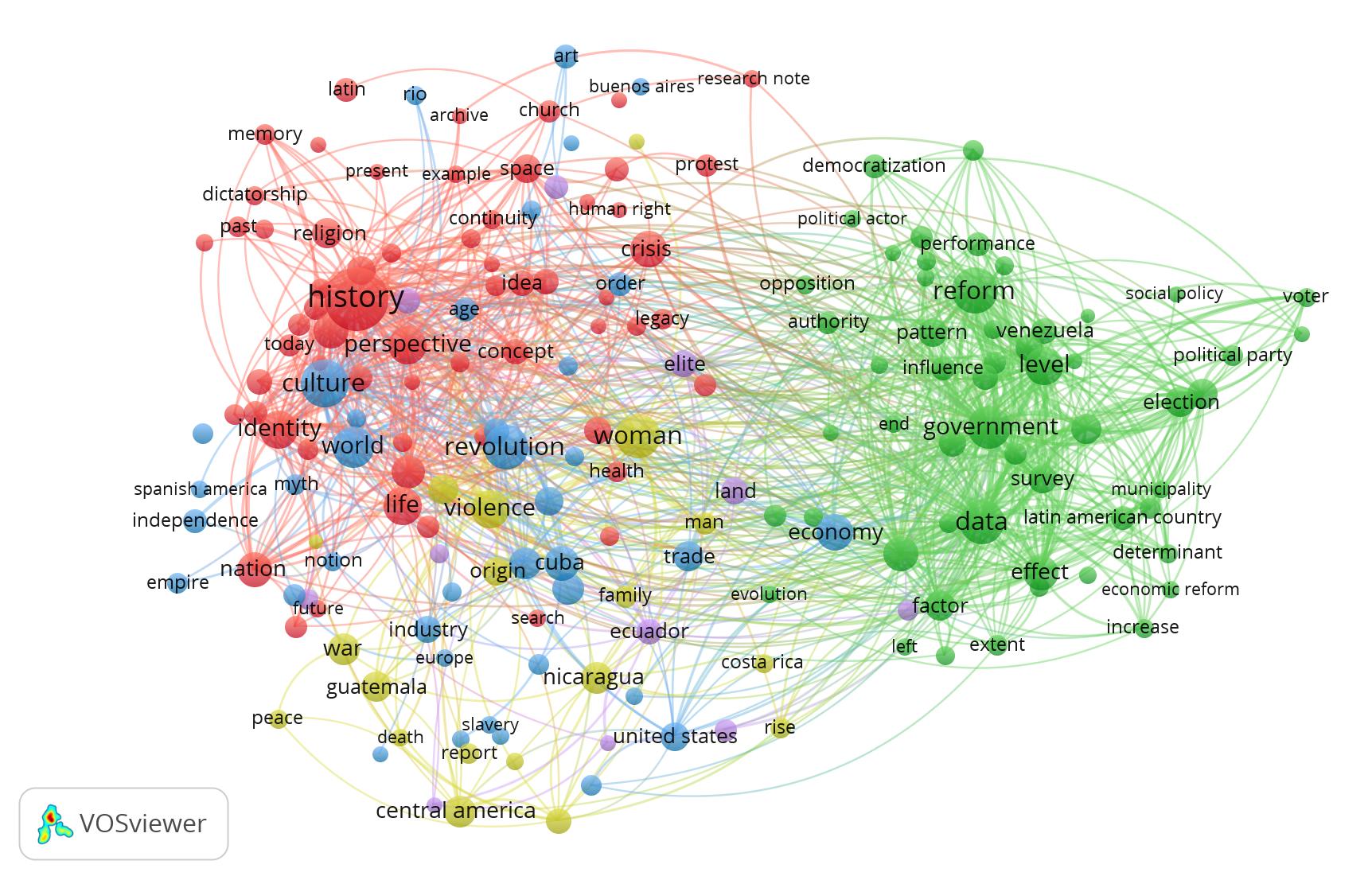
By removing “America,” I was able to more easily see the relationships between other key words.
In general, the networks remained similar with only slight changes. Main nodes such as “culture” and “world” changed clusters. Likewise, “violence” was originally grouped with “revolution,” but after I removed “America” “violence” changed to the cluster that included “women.” What in the program’s algorithm would shift these words and clusters? These two images may lead to different assumptions/conclusions of the journal’s subject matter.
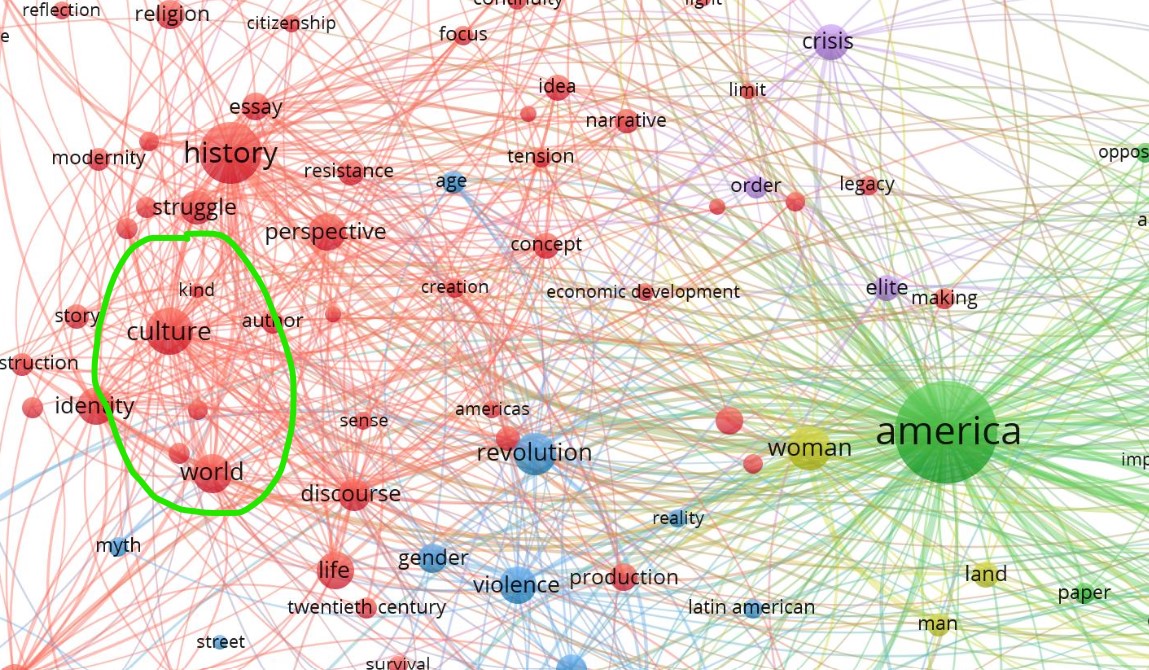
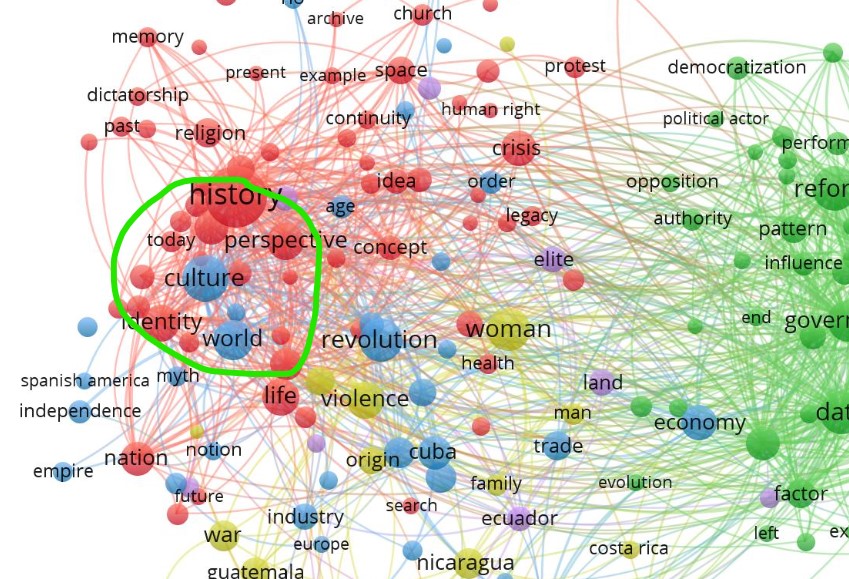
Next is the Hispanic American Historical Review (2,692 search results, 6680 terms with 103 meeting the threshold = 1.5%):
“Published in cooperation with the Conference on Latin American History of the American Historical Association. Hispanic American Historical Review pioneered the study of Latin American history and culture in the United States and remains the most widely respected journal in the field. HAHR’s comprehensive book review section provides commentary, ranging from brief notices to review essays, on every facet of scholarship on Latin American history and culture.”
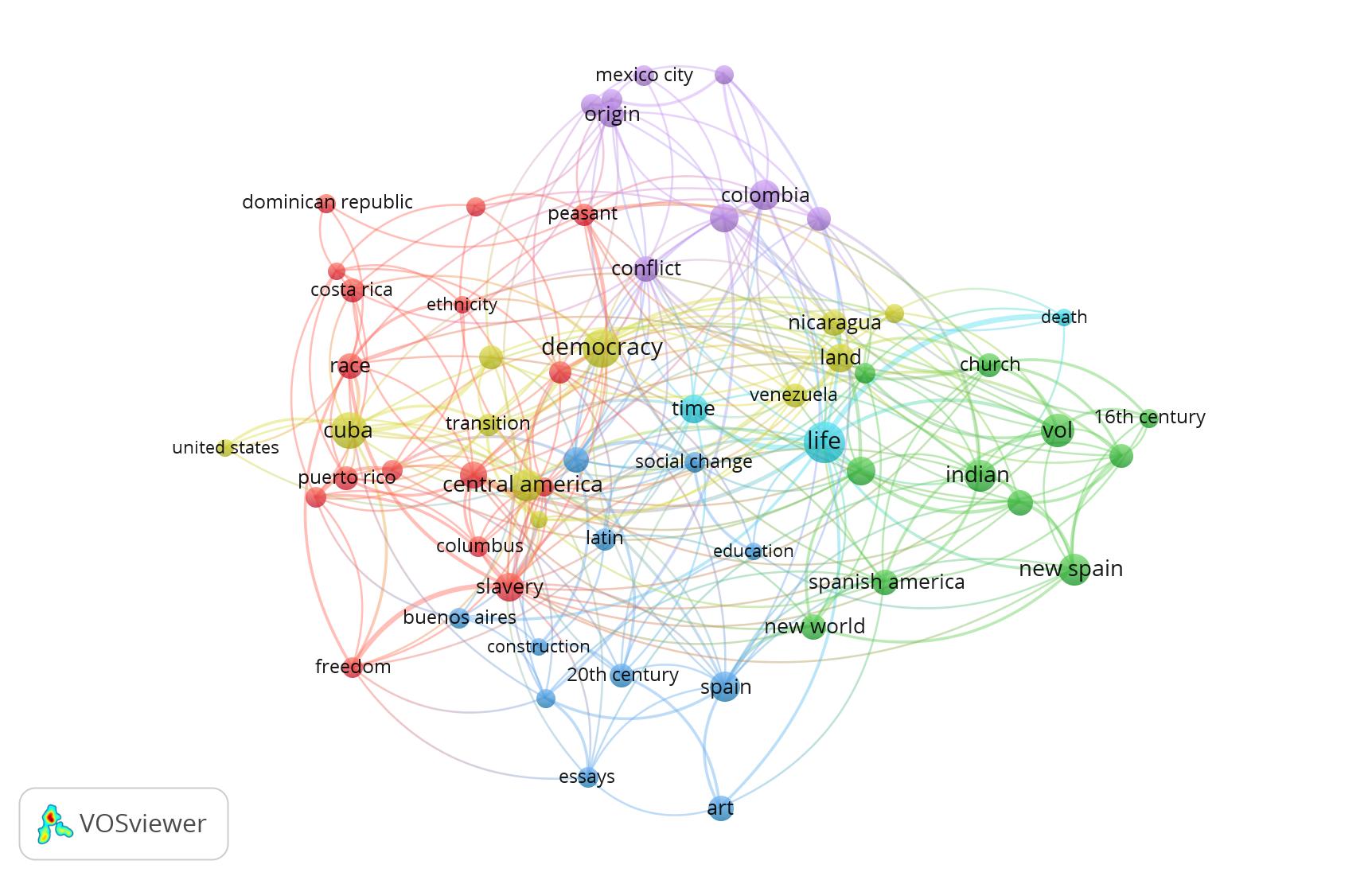
Why were there far fewer items for this journal according to VOSviewer? Above, LARR had over 16,000 terms to calculate while HAHR only had 6,000. How does the program determine the terms it will use? As with LARR, I removed the term “america” from HAHR’s calculation. How does the program differentiate between individual words like “central,” “spanish,” and “america,” and phrases like “central america,” or “spanish america?”
Another journal I researched was the Revista de Indias (1452 search results; 9580 terms with 202 meeting the threshold = 2.1%):
“Since 1940, Revista de Indias is a a well-known forum for debates in the History of America targeted to specialized readers. It publishes original articles aimed at improving knowledge, encouraging scientific debates among researchers, and promoting the development and diffusion of state-of-the-art investigation in the field of the History of America. The contents are open to different topics and study areas such as social, cultural, political and economical, encompassing from the Pre-Hispanic world to the present Ibero-American issues. The Journal publishes articles in Spanish, English and Portuguese. Besides the regular issues, one monographical issue is published every year.”
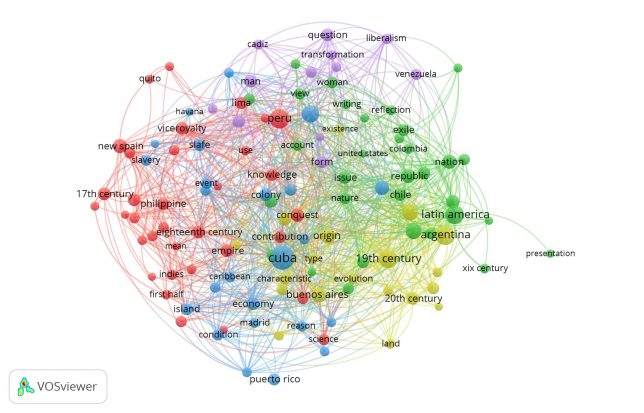
You can see that this journal has several publications focused on Cuba and Peru with other locations like Argentina, Puerto Rico, New Spain, and Quito on the peripheries.
The journal Luso-Brazilian Review is a smaller, more specific journal (534 search results; 2733 terms with 17 meeting the threshold = 0.6%):
“Luso-Brazilian Review publishes interdisciplinary scholarship on Portuguese, Brazilian, and Lusophone African cultures, with special emphasis on scholarly works in literature, history, and the social sciences. Each issue of the Luso-Brazilian Review includes articles and book reviews, which may be written in either English or Portuguese.”
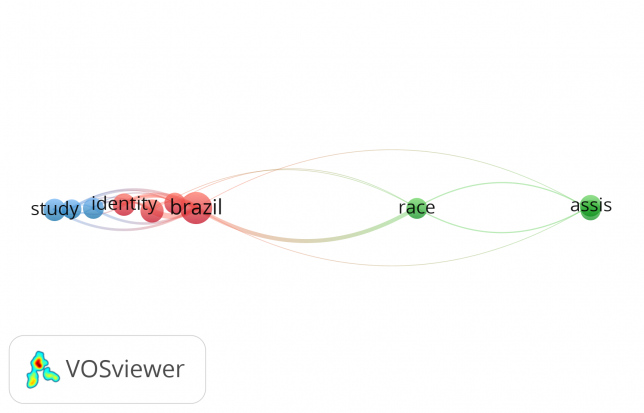
I’m unsure why the spacing on the right side is so wide. If you were to zoom in on the blue cluster it reads from left to right, “study, time, Portugal,” and the red, “identity, history, politic, and Brazil.” Oddly enough, the overlapping green cluster on the far right consists of two nodes, “Assis” and “Machado.” Joaquim Maria Machado de Assis is one individual, an author from the 19th century who is often referred to as “Machado de Assis” – why would the program split his name? As a smaller journal with a more specified topic, it makes sense that there are fewer search results, fewer terms, and yet fewer that reached the threshold. LBR has the lowest percentage of terms that met the threshold at only 0.6%.
Lastly, I investigated the Journal of Latin American Studies (3733 search results; 16,217 terms of which 330 met the threshold = 2%)
“Journal of Latin American Studies presents recent research in the field of Latin American studies in development studies, economics, geography, history, politics and international relations, public policy, sociology and social anthropology. Regular features include articles on contemporary themes, short thematic commentaries on key issues, and an extensive section of book reviews.”
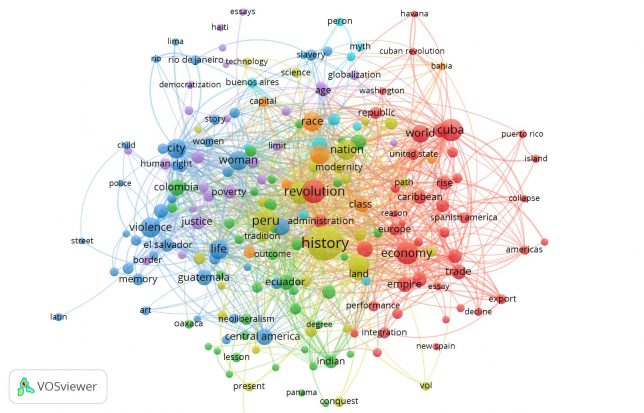
You can see that, although the journal advertises a large plethora of fields of study, History sits in the center. JLAS shares similar size and terms as the LARR (the first journal above). “History,” “revolution,” “Peru,” “violence,” and “Cuba” are some terms that stand out to me. It would be interesting to speculate as to why that is… it could relate to the common scholarly interests of researchers, or their trainings, or the availability of funds to study these terms, or accessibility of archives, or the sexiness of the topic and location… Comparing the two journals may yield interesting findings about the field and its publications.
I was also interested in the JLAS’s change over time.
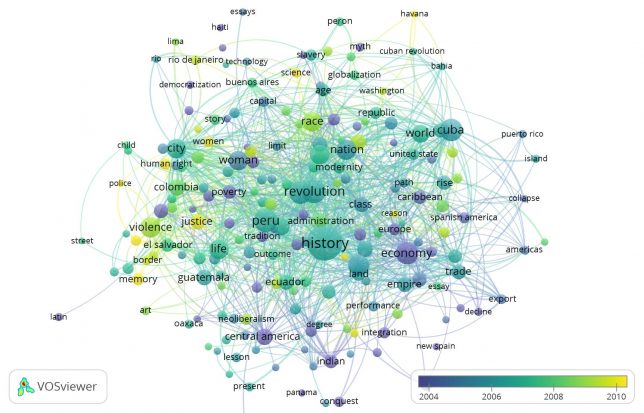
So here we have the same map as above, but viewed through the “Overlay Visualization,” which, according to the manual, indicates impact factor. You can see the shift from “economy” on the right, to “revolution” in the center, to “memory” on the left. What I don’t understand about this map’s key of 2004 – 2010 is if, for example, “economy” was at its peak impact in 2004 and slowly decreased in relation to the other terms (and that’s why it is purple), or if “economy” remained impactful through 2010 and was joined by other terms.
Overall, I found this exercise entertaining. I was able to see the frequency of certain terms and their relationship with other terms, while comparing the different journals. I find the visual representations of each journal to correspond with it’s description. The difference in subject matter topics of the different journals may be implicit to those in the field. The networks provide a visualization for those differences.
Jim
February 18, 2020 — 11:10 am
Oh, I see now after having read the chapter by Nees Jan van Eck and Ludo Waltman. To understand the clustering function and its algorithm I would need to read:
Waltman, L., Van Eck, N.J., & Noyons, E.C.M. (2010). A unified approach to mapping and clustering of bibliometric networks. Journal of Informetrics, 4(4), 629–635.
&
Waltman, L., & Van Eck, N.J. (2013). A smart local moving algorithm for large-scale modularity-based community detection. European Physical Journal B, 86, 471.